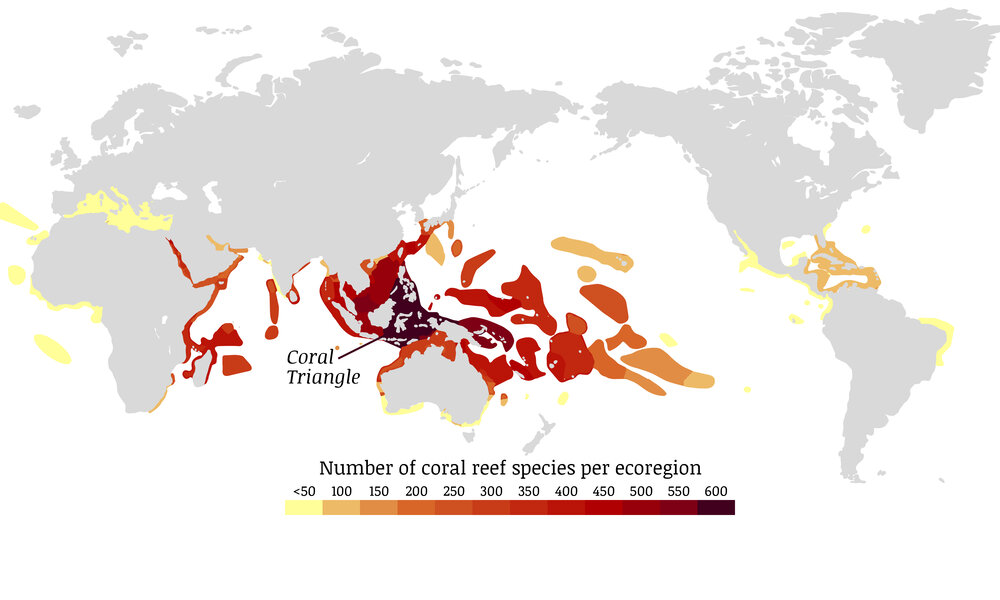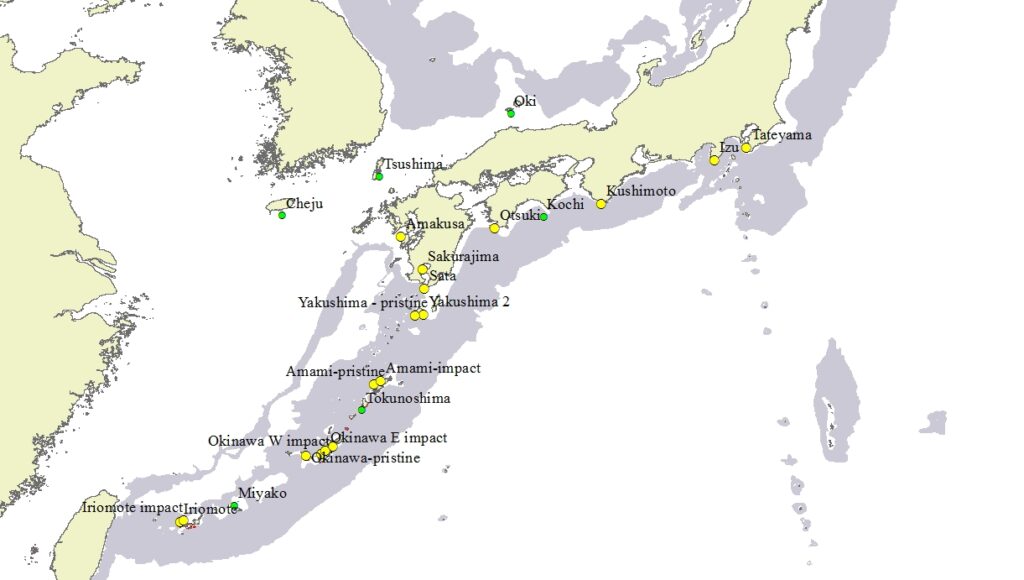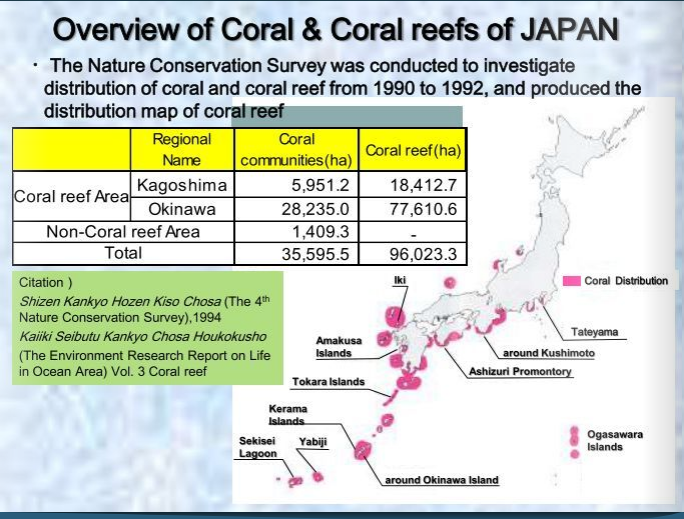Geography
Japan's Biodiversity
a major marine biodiversity hotspot
Multiple factors contribute directly to giving the islands of the Japanese archipelago, both on land and underwater, their environmental richness, and also an outstanding marine biodiversity.
A major factor is Japan’s geographical position along the Eurasian coast and span of latitude, the country’s 30,000+ km long coastline extending from subarctic to subtropical conditions, with a complex underwater topography, with bays giving access to both shallow and deep water ecosystems.
Another factor is the archipelago’s marked seasonal temperature changes and exposure to key warm and cold-water currents, including the powerful Kuroshio-Oyashio system, which directly connect Japanese waters to neighbouring marine ecosystems.
The Japanese archipelago separates the Pacific Ocean from the Sea of Japan (the marginal sea between the Japanese islands, Sakhalin, the continental landmasses of the Korean Peninsula, and the Russian mainland), yet these two major water environments are interconnected by the currents flowing along all the coasts of the Japanese islands.
The Sea of Japan, as an enclosed sea, has almost no tides, and also a lower faunal diversity and salinity than in the Pacific side, which faces open ocean.
However, the Sea of Japan’s seawater also has an elevated concentration of dissolved oxygen that results in high biological productivity, and it is directly connected to neighbouring seas and to the Pacific Ocean by the inflow and outflow of currents through its various straits, including Kuroshio’s Tsushima branch of warm current and the Liman cold current.
Marine Species in Japan – Chart source: opbio.com
A 2010/2011, the White Paper on Fisheries of Japan listed the following primary factors contributing to the general richness of Japanese waters:
- The Oyashio Current (rich in nutrient salt and encourages plankton growth) and the Kuroshio Current (although poor in nutrient salt, brings fish from southern sea areas to waters around Japan) intersect and form an “Avenue of Fish.“
- Continental shelves have developed along the coasts of Hokkaidō, the Tōhoku region, and the San’in region at a depth of approximately 200 m, which is suitable for the habitats of bottom fish. Meanwhile, the Sea of Japan has the Yamato Bank and the Musashi Bank, which are terrace-shaped shallow sea areas.
- The East China Sea, and many of the inner bays (such as the Funka Bay, Ise Bay, Ariake Sea, and Yatsushiro Sea) found along Japanese coastlines provide grounds for abundant fishery resources due to the rich nutrient salt carried in from land areas.

Image source: blogs.ubc.ca
A dynamic warm/cold water current system
The major ocean currents flowing along the Japanese islands collectively support biodiversity in the area, which counts among some of the most productive and diverse regions in the world in terms of both cold and warm water marine life.
This has historically been a great asset for Japan’s powerful fishing industry, but also generates fantastic conditions for more contemplative and leisurely activities such as scuba-diving.
Out of these currents, the Kuroshio-Oyashio current-system has the strongest influence both on marine life and conditions found in Japanese waters, to which it gives warmth and good visibility, coral reefs and biodiversity.

Image base: プレゼンテーション jaea.go.jp
Another indirect effect of the Kuroshio-Oyashio current system is the creation of powerful coastal upwellings, which, combined with Japan’s unique and complex, mostly volcanic-based underwater topography, and in some places access to deeper water, contributes to bringing a flow of deep colder water up to the surface, and with it deep-water marine life that is rarely seen elsewhere…
Looking at the path of the Kuroshio, we see that it originates within an area called the Western Pacific Warm Pool, and specifically from the Pacific North Equatorial Current, which first runs westward along the Equator.
This current then heads towards the Philippines, flowing through the east-side of South-East Asia’s highly biodiverse Coral Triangle area, in other words, through one of the major marine biodiversity centres in the world, before heading northwards towards the islands of Japan…
This is one of the reasons why the Ryū-Kyū Island’s coral reefs also form one of the worlds’ richest centres of multi-taxon endemism.
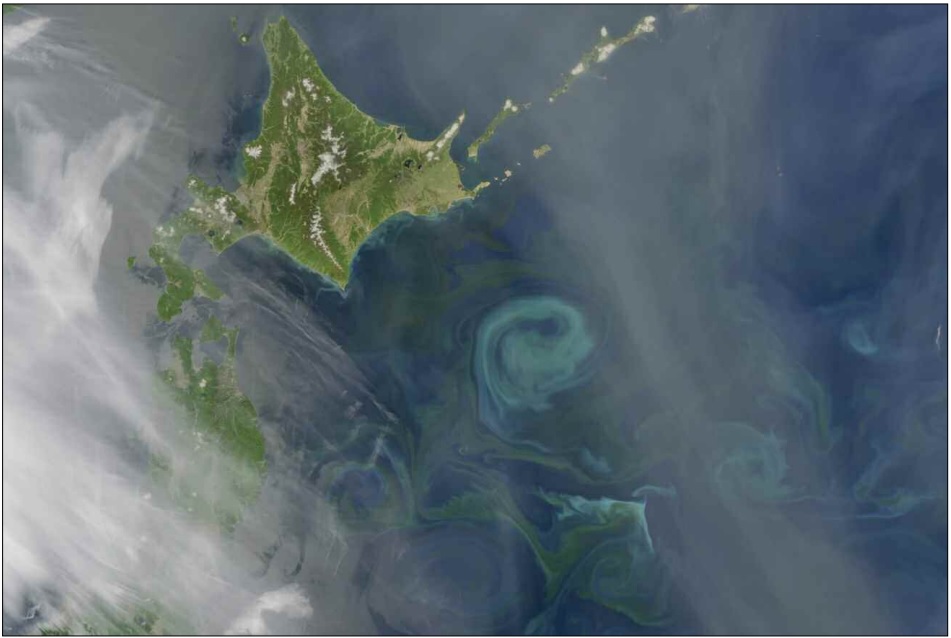
Image source: earthdata.nasa.gov
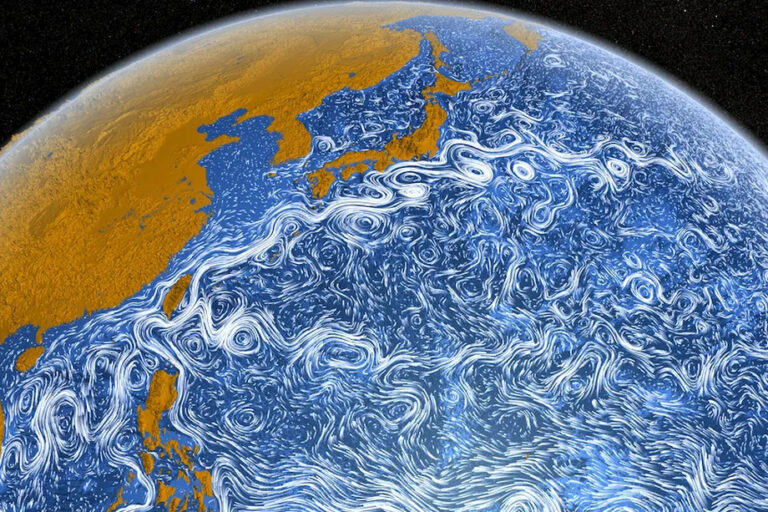
Image source: NASA svs.gsfc.nasa.gov
Seasonal temperature differences and current variations encountered in Japanese waters also account for large spawning and feeding events, and also migratory movements of marine mammals such as humpback whales, sperm whales, pilot whales and other cetaceans, found along the coasts of Japan in the cooler months.
Coral
Similar to the Atlantic’s Gulf Stream in its mode of creation and flow patterns, the Kuroshio has an important warming effect upon the south and southeast coastal regions of Japan, as far north as Tōkyō.
The warm waters of Kuroshio also sustain coral reefs across the Japanese islands, which develop at higher latitude than elsewhere.
These include the recently discovered cold and shallow water coral colonies of Tsushima Island, in the Korea Strait between mainland Japan and the Korean peninsula, or those Wakayama Prefecture in central Honshū, which are thought to constitute the northernmost shallow coral reef ecosystem in the world.
Although Japan’s coral fauna has not been fully elucidated, the total number of Japanese corals is estimated at roughly 415 species for coral reef areas (from the Yaeyama Archipelago to the Amami Archipelago in the Nansei Islands), roughly 200 species for non-reefal communities (from Tanegashima to the Kii Peninsula), and also roughly 55 species for outlying coral communities (from the Izu Peninsula to Tōkyō Bay).
It should be mentioned that a considerable section of Japan’s coral reefs have also been severely damaged by sedimentation from construction and agricultural activity, and also by overfishing.
Current land development project also poses a serious threat in some areas, and we hope to see a strengthening of conservation efforts in the future, like those that have begun in Okinawa and elsewhere, as the loss of these ecosystems would be a serious loss for biodiversity in the area.
Especially since spikes in water temperatures are also affecting Japanese waters. Temperature changes caused coral of the Nansei islands to expand their habitat range further north, in waters with lower temperatures. But these are now also threatened.
In 2015/2016, for instance, a bleaching event also damaged 30% of the world’s northernmost coral reef on Tsushima Island…
Image source: Coral Triangle Atlas ctatlas.reefbase.org/
Image source: Coral Reef MPA and Conservation Program in Japan
The Japanese Ministry of the Environment has a collection of English references on coral in Japan and conservation issues accessible here: http://www.env.go.jp/nature/biodic/coralreefs/reference/contents.html
155,000 species call Japanese waters home?!
In 2010, a report entitled “Marine Biodiversity in Japanese Waters“, based on research undertaken by the Japan Agency for Marine-Earth Science and Technology (JAMSTEC) and research groups of Kyōto and Tōkyō Universities, came to the conclusion that the marine habitats surrounding Japanese islands (= Japan’s Excusive Economic Zone) are currently home to roughly 34,000 species (including 3,000 different types of fish but also great diversity of bacteria, mammals and deep-sea creatures), which would account for 14.6 percent of all 230,000 marine species found worldwide.
This means Japanese waters hold some the richest marine ecosystems in the world, comparable to Australian waters, and form a major biodiversity hotspot.
The report also estimates that roughly 122,000 unclassified species have been observed in these waters, which would bring the total to 155,000 species found in Japanese waters…
The 2010 JAMSTEC study attributes this outstanding result to the diversity of marine environments encountered in Japanese waters, including its various climate zones and water temperatures, cold and hot water currents, water depth ranges and topography (see here for more details on JAMSTEC research, and here for related links on the subject)



